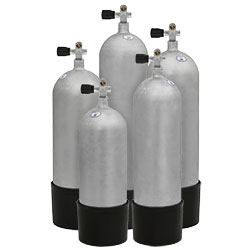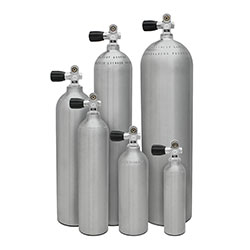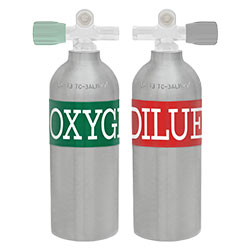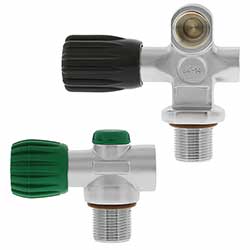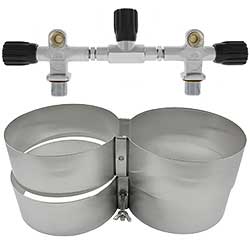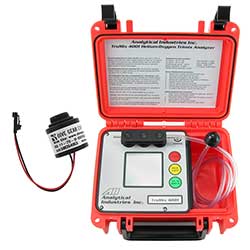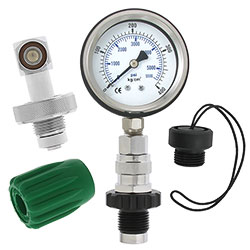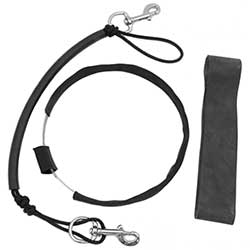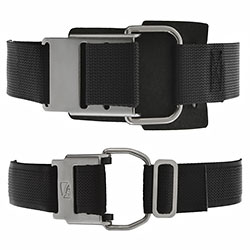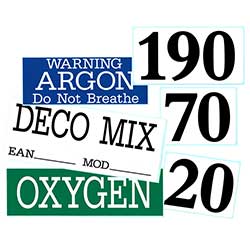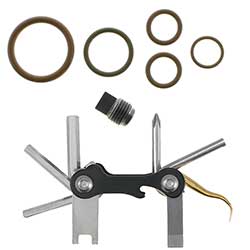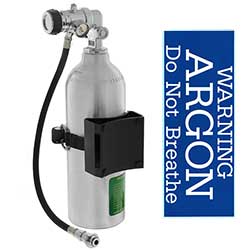Or why does my Aluminum 80 SCUBA tank only hold 77 cubic feet of air?
©2018-2020 by Mark Derrick, Gas Blending Instructor at Dive Gear Express
Technical divers need to know exactly how much breathing gas they have as they enter the water, because if they didn't plan correctly then bad stuff can happen. You can just accept that the names used to describe some SCUBA cylinders have a weak relationship to their actual free air capacity, because otherwise this STEM heavy article is going to take you on a journey through some gas thermodynamics for divers. If you don't find that interesting, skip to the Table of True Capacities for Common SCUBA Cylinders.
Descriptions of the amount of air in SCUBA cylinders (aka diving tanks) as well as conversions between cylinders intended for imperial markets and their metric equivalents are very problematic because not all manufacturers and distributors do their math the same way, and of course neither do the divers. This article is going to show you an easy way to determine exactly how much breathing gas is really contained in any imperial or metric SCUBA cylinder, but we have to get a few housekeeping details out of the way first...
SCUBA cylinders in the US are regulated by standards of the Department of Transportation, Hazardous Materials Division (aka the DOT) and are described in commerce by their free air capacity in cubic feet for the service pressure in pounds per square inch. Internationally, most SCUBA cylinders are regulated by standards of the European Union (EN numbers) or International Standards Organization (ISO numbers) and are described by their water volume in liters and working pressure in bar. This article is making a careful distinction between the terms capacity of gas and volume of water, but technically they are both volumes regardless of their units of measurement in cubic feet or liters {ft3 | L}. Because gases are extremely compressible compared to liquids, a volume of gas such as air is ordinarily expressed in relationship to a pressure as pounds per square inch or bar { psi | bar }. The term capacity means the gas volume at one Standard Atmosphere of pressure {14.696 psi | 1.01325 bar}, also called the "free capacity".
The ideal capacity is determined using a Boyle's law ideal gas equation. At room temperature and pressures less than about {2030 psi | 140 bar}, air behaves very closely to the ideal gas laws. However, as pressures increase, the calculated ideal capacity increasingly deviates from the observed real capacity. That is because the ideal gas is perfectly compressible but real gases have limitations with their compressibility due to the atomic forces of their specific composition. The effect of differences in temperature on cylinder capacity is also important. The capacity can be very significantly less depending on the breathing gas, working pressure and temperature of the SCUBA cylinder: from 5% to 10% less for air or sport Nitrox, and 10% to 20% less for Trimix. There are several different methods to calculate the true capacity, a very close approximation of the real capacity.
Ok, here is the good stuff: To calculate ideal capacity, multiply the cylinder water volume by the cylinder pressure and divide by atmospheric pressure. (Divers using metric cylinders usually get that last part wrong.) The easiest method to estimate true capacity is to use the Compressibility Factor (Z). To calculate true capacity, divide the ideal capacity by the Z Factor for the specific gas at the same pressure. Values for Z can be looked up in a Z Factor reference table or can be computed from experimental data for real properties of a specific gas. The Z Factors used in this article were computed using the NIST REFPROP database and software.
Ideal_Capacity(ft3) = Water_Volume(ft3)
× Service_Pressure(psi) ÷ Atmospheric_Pressure(14.696 psi)
Ideal_Capacity(L) =
Water_Volume(L)
× Working_Pressure(bar)
÷ Atmospheric_Pressure(1.01325 bar)
True_Capacity ≈
Ideal_Capacity
÷ Z_Factor(gas & pressure@temperature)
SCUBA cylinder manufacturers and distributors publish the basic information you need to make make these simple calculations. From their specifications you need only find the water volume and pressure for your SCUBA tank. International divers have it easy, those two values are usually stamped on the crown of the cylinder as WC and WP. You also need the temperature in order to determine the Z Factor and these calculations also assume the temperature is the same for both ideal and true capacity. If temperature is not stated in the specifications, the US standard is 70°F and most international standards are 15°C. (FYI, they are not equivalent, 15°C is only 58°F.) Authoritative sources for the cylinder water volumes and pressures mentioned in this article were the Luxfer website published technical specifications (imperial), the private engineering database at Faber, plus direct communications with XS Scuba (aka Sea Pearls) for Metal Impact.
Aluminum "S80" (Luxfer DOT) US Specifications
- Water Volume = 678 in3 (1728 in3 = 1 ft3)
- Service Pressure @ 70°F = 3000 psi
- Ideal capacity (678÷1728) ×3000 ÷14.696= 80.1 ft3
- Z Factor = 1.0320
- True capacity 80.1 ÷1.0320 ≈ 77.6 ft3
The 77.6 ft3 true air capacity varies slightly from the Luxfer technical specifications of 77.4 ft3. Luxfer engineers may have determined compressibility using a method with different accuracy, may have performed calculations with different precision, or may have done improper conversions between imperial and metric standards. Frankly, small differences in accuracy and precision are not important for sport diving. Unfortunately, the various small differences can compound to become genuinely significant to pre-dive gas planning for technical diving and can be critical for sending stuff to Mars.
Aluminum "Ali 80" (Luxfer EN/ISO) International Specifications
- Water Volume = 11.1 L
- Working Pressure @ 15°C = 207 bar
- Ideal capacity 11.1 ×207 ÷1.01325 = 2268 L
- Z Factor =1.0263
- True capacity 2268 ÷1.0263 ≈ 2210 L
The water volume specification available for DOT cylinders is usually cubic inches or liters, so start DOT calculations by converting the water volume in to cubic feet. However, conversions between metric and imperial cylinder free capacities are more complex than simple units conversions. The international "Ali 80" cylinder is physically the same as the US "S80", both manufactured by Luxfer. So why is the true air capacity of the international cylinder, simply converted to imperial units 2210÷28.32 = 78.0 ft3, not the same as the domestic cylinder at 77.6 ft3? The reason is small differences in temperature and pressure between the EN/ISO and DOT standards. This is why simple units conversion of free capacity between imperial and metric cylinders is improper, becoming more significant as the water volume or pressure increases particularly for manifolded cylinders (aka "doubles" or "twinsets".)
XS Scuba Steel X7-100 (Faber DOT) US Specifications
- Water Volume = 12.9 L (28.32 L = 1 ft3)
- Service Pressure @ 70°F = 3442 psi
- Ideal capacity (12.9÷28.32) ×3442 ÷14.696 = 106.7 ft3
- Z Factor = 1.0532
- True capacity 106.7 ÷1.0532 ≈ 101.3 ft3
Did you ever wonder how the peculiar service pressure value of 3442 came to be established? The first US manufactured high pressure steel SCUBA cylinder (designed by Pressed Steel Tank Company circa 1987) had a 3500 psi service pressure that could only be used with 300 bar DIN valves and regulators; a considerable annoyance to sport divers in North America who overwhelmingly use yoke fitting regulators. In 2004, PST introduced a new design that could be used with yoke (aka A-clamp) regulators. The international standard at the time for a yoke connection maximum cylinder working pressure was 230 bar at 15°C. However, DOT specifications are in pounds per square inch at a different temperature, so some conversions had to be done...
(Nerd alert!) The Gay-Lussac's law of pressure–temperature says that the pressure of the ideal gas will vary in direct proportion to it's temperature (for a constant volume.) Every diver understands the effect of this gas law as what happens when they get a "hot fill" that cools with a resulting pressure drop, but the inverse is also true. Instead of using ideal calculations, PST used software to model the properties of dry Air as a mixture of pure nitrogen, argon and oxygen. The engineers determined for a cylinder filled to a gas density of ≈9.24 moles per liter and pressure of 230 bar at 15°C then warmed up to 70°F, the pressure would have to be {3442.7 psi | 237.4 bar} to maintain the exact same density. Thus the 230 bar @15°C metric standard became the 3442 psi @70°F imperial standard in the US. The original 230 bar has since been superseded by the ISO 12209:2013 standard of 232 bar, so the DOT maximum cylinder service pressure could hypothetically be 3472 psi if it were established today using the same method. Here is a screen shot of my repeat results using different software. (Cancel the nerd alert.)
CAUTION TO TECHNICAL DIVERS: The true capacity values shown in the charts below are for relatively warm air and Heliair 10/50 as the breathing gas, but technical divers use a lot of different mixed gases and often dive in colder temperatures. Compared to air, the true Trimix capacities are significantly LESS because helium is relatively less compressible than air. For example: A set of double HP117's has a true air capacity of ≈235 ft3, but only holds ≈216 ft3 of Heliair 10/50. You can use our Z Factors for SCUBA table to determine true capacities of your cylinders with a variety of mixed gases. Most divers don't think about the effect of water temperature on capacity but that matters too. Go diving under ice in {38°F | 3°C} water using your double AL80's and now you have ≈14 ft3 LESS of air than you did when they were filled at 70°F.
Capacity calculations ignore the facts that it is difficult for a diver to breathe the residual gas in a SCUBA tank below about {150 psi | 10 bar} due to regulator flow restrictions and that pressure gauges can be significantly inaccurate, so best practice is to always plan your dive with a generous reserve.
| Table of True Capacities for Common SCUBA Cylinders (US/DOT) | |||||||
|---|---|---|---|---|---|---|---|
| SCUBA Cylinder Common Name |
Water Volume |
Service Pressure |
Ideal Gas Capacity |
Air Z Factor |
True Air Capacity |
Heliair 10/50 ☆ Z Factor |
True 10/50 Capacity |
| AL6: Aluminum XS-6 (Sea Pearls/Metal Impact) | 50.5 in3 | 3000 psi | 6.0 ft3 | 1.0320 | ≈ 5.8 ft3 | 1.1233 | ≈ 5.3 ft3 |
| AL8 (Inflation): Aluminum XS-8 (Sea Pearls/Metal Impact) | 95.3 in3 | 2015 psi | 7.6 ft3 | 0.9984 | ≈ 7.6 ft3 | 1.0784 | ≈ 7.0 ft3 |
| AL13 (CCR 2L): Aluminum XS-13 (Sea Pearls/Metal Impact) | 112 in3 | 3000 psi | 13.2 ft3 | 1.0320 | ≈ 12.8 ft3 | 1.1233 | ≈ 11.8 ft3 |
| HP15 (CCR 2L): Steel BSE15 (Blue Steel/Faber) | 2.0 L | 3442 psi | 16.5 ft3 | 1.0532 | ≈ 15.7 ft3 | 1.1446 | ≈ 14.4 ft3 |
| AL19 (CCR 3L): Aluminum XS-19 (Sea Pearls/Metal Impact) | 160 in3 | 3000 psi | 18.9 ft3 | 1.0320 | ≈ 18.3 ft3 | 1.1233 | ≈ 16.8 ft3 |
| AL20 (CCR 3L short): Aluminum S20 (Dive Rite/Catalina) | 175.5 in3 | 3000 psi | 20.7 ft3 | 1.0320 | ≈ 20.1 ft3 | 1.1233 | ≈ 18.4 ft3 |
| HP23 (CCR 3L): Steel BSE23 (Blue Steel/Faber) | 3.0 L | 3442 psi | 24.8 ft3 | 1.0532 | ≈ 23.5 ft3 | 1.1446 | ≈ 21.7 ft3 |
| LP27 (CCR 4L): Steel BS27 (Blue Steel/Faber) | 4.0 L | 2640 psi | 25.4 ft3 | 1.0173 | ≈ 25.0 ft3 | 1.1064 | ≈ 22.0 ft3 |
| AL30: Aluminum XS-30 (Sea Pearls/Metal Impact) | 254 in3 | 3000 psi | 30.0ft3 | 1.0320 | ≈ 29.1 ft3 | 1.1233 | ≈ 26.7 ft3 |
| AL40: Aluminum S40 (XS Scuba/Luxfer L6X) | 350 in3 | 3000 psi | 41.3 ft3 | 1.0320 | ≈ 40.0 ft3 | 1.1233 | ≈ 36.8 ft3 |
| LP50: Steel BS50 (Blue Steel/Faber) | 7.8 L | 2640 psi | 49.5 ft3 | 1.0173 | ≈ 48.7 ft3 | 1.1064 | ≈ 44.7 ft3 |
| AL72: Aluminum XS-72 (Sea Pearls/Metal Impact) | 610 in3 | 3000 psi | 72.1 ft3 | 1.0320 | ≈ 69.9 ft3 | 1.1233 | ≈ 64.2 ft3 |
| AL80: Aluminum S80 (XS Scuba/Luxfer L6X) | 678 in3 | 3000 psi | 80.1 ft3 | 1.0320 | ≈ 77.6 ft3 | 1.1233 | ≈ 71.3 ft3 |
| LP85: Steel BS85 (Blue Steel/Faber) † | 13.0 L | 2640 psi | 82.5 ft3 | 1.0173 | ≈ 81.1 ft3 | 1.1064 | ≈ 74.6 ft3 |
| HP80: Steel X7-80 HDG (XS Scuba/Faber) | 10.2 L | 3442 psi | 84.4 ft3 | 1.0532 | ≈ 80.1 ft3 | 1.1446 | ≈ 73.7 ft3 |
| HP100: Steel X7-100 HDG (XS Scuba/Faber) | 12.9 L | 3442 psi | 106.7 ft3 | 1.0532 | ≈ 101.3 ft3 | 1.1446 | ≈ 93.2 ft3 |
| HP117: Steel X8-117 HDG (XS Scuba/Faber) | 15.0 L | 3442 psi | 124.1 ft3 | 1.0532 | ≈ 117.8 ft3 | 1.1446 | ≈ 108.4 ft3 |
| HP120: Steel X7-120 HDG (XS Scuba/Faber) | 15.3 L | 3442 psi | 126.5 ft3 | 1.0532 | ≈ 120.1 ft3 | 1.1446 | ≈ 110.5 ft3 |
| HP133: Steel X8-133 HDG (XS Scuba/Faber) | 17.0 L | 3442 psi | 140.6 ft3 | 1.0532 | ≈ 133.5 ft3 | 1.1446 | ≈ 122.8 ft3 |
| DOT Service Pressure in psi gauge @ 70°F • Capacity at 14.696 psi absolute @ 70°F | |||||||
|
Calculated values are nominal and may not match manufacturer specifications or reality. Actual free gas capacity depends on settled pressure, temperature, gas composition and other stuff. |
|||||||
☆ Heliair 10/50 is not a particularly good breathing gas for open-circuit divers, with questionable suitability as an inflation gas. Heliair always is less than optimal for either PO2 or narcosis, depending on your TOD. However, Heliair is easy to make so it is widely used and the reason it appears in this table.
† Many years ago the first US importer of Faber low pressure 2400+10% = 2640 psi steel cylinders did some specious math for the marketing descriptions of their capacities. The 13 ×(2640÷14.5) ÷28 = 85 ft3(?) description has followed this 13 liter water capacity cylinder through the years and it is still referred to in the US as the "LP85" because the name has become synonymous with it's excellent buoyancy characteristics and in-water trim, even though 85 ft3 is no where near it's true capacity. The cylinders were notorious for being overfilled by technical divers because of how they were marketed by the importer, who claimed their service life was 10,000 hydrostatic tests at 4000 psi. North Florida cave country divers called their 4000 psi overfill a "dry hydro", but at that pressure the real gas behaviors become even more significant and the overfill benefit is diminished by a whopping ≈10 ft3. Regardless, the practice became so widespread that Faber eventually started stamping the US import version "DO NOT OVER PRESSURIZE".
| Table of True Capacities for Common SCUBA Cylinders (EN/ISO) | |||||||
|---|---|---|---|---|---|---|---|
| SCUBA Cylinder Common Name |
Water Volume (WC) |
Working Pressure (WP) |
Ideal Gas † Capacity |
Air Z Factor |
True Air Capacity |
Heliair 10/50 Z Factor |
True 10/50 Capacity |
| Aluminum "Ali 80" (Luxfer) | 11.1 L | 207 bar | 2268 L | 1.0263 | ≈ 2210 L | 1.1246 | ≈ 2017 L |
| Steel 10 Liter (Faber) | 10.0 L | 232 bar | 2290 L | 1.0438 | ≈ 2194 L | 1.1423 | ≈ 2005 L |
| Steel 12 Liter (Faber) | 12.2 L | 232 bar | 2793 L | 1.0438 | ≈ 2676 L | 1.1423 | ≈ 2445 L |
| Steel 12 Liter 300 BAR (Faber) | 12.2 L | 300 bar | 3612 L | 1.1020 | ≈ 3278 L | 1.1927 | ≈ 3028 L |
| Steel 15 Liter (Faber) | 15.0 L | 232 bar | 3434 L | 1.0438 | ≈ 3290 L | 1.1423 | ≈ 3006 L |
| Steel 18 Liter (Faber) | 18.0 L | 232 bar | 4121 L | 1.0438 | ≈ 3948 L | 1.1423 | ≈ 3608 L |
| EN/ISO Working Pressure in bar gauge @ 15°C • Capacity at 1.01325 bar absolute @ 15°C | |||||||
|
Calculated values are nominal and may not match manufacturer specifications or reality. Actual free gas capacity depends on settled pressure, temperature, gas composition and other stuff. |
|||||||
† A 10 L cylinder at 232 bar does not contain 2320 free liters of air! Divers using metric cylinders are fond of saying they don't have to deal with this stuff, just multiply the water volume in liters by the working pressure in bar, but that's not entirely correct. Many divers think that atmospheric pressure is defined as 1 bar. A bar is actually defined as exactly 10 meters of sea water, not 1 atmosphere. The metric calculation typically used by divers omits the division by atmospheric pressure, which is 1.01325 bar. That makes the ideal capacity overstated by 1.3% plus the difference between ideal and true capacity for a total variance of ≈8% at 232 bar and ≈11% at 300 bar. Notice the "Ali 80" actually has a larger true capacity compared to the "10 Liter" with a larger ideal capacity; that's the effect of compressibility between the two different working pressures.
For similar water volumes, the 232 bar cylinders are similar in true capacity to the 3442 psi cylinders. Comparing the ISO "15 Liter" with the DOT "HP117", they look identical with the same diameter and the ISO version longer by just 5 mm. They do differ in weight and buoyancy, with the ISO version being 0.5 kg heavier. They are both made by Faber, so could it be that to yield the same water volume the ISO cylinder is slightly taller because it has a thicker cylinder wall than the DOT cylinder? Divers are sometimes heard to say that cylinders in the US are the same as cylinders elsewhere; this is an example why that may not be true even for cylinders that are very close in size and pressure.
We get a lot of different questions from even experienced divers trying to understand and reconcile the various features and diving applications of scuba tanks. If that's you, then you might benefit from reading the most popular article on our website. How to Select a SCUBA Tank is a very detailed whitepaper focused on helping divers choose the best SCUBA tank for their specific needs and styles of diving.
